Swordtail fish (lat. Xiphophorus hellerii) is one of the most famous and spread tank fishes. In general this fish is quite peaceful and it can inhabit in a common tank. Though each fish may have its own temper, which can be both timid and shy or aggressive and blusterous. This is especially true for males. They can be aggressive towards each other.
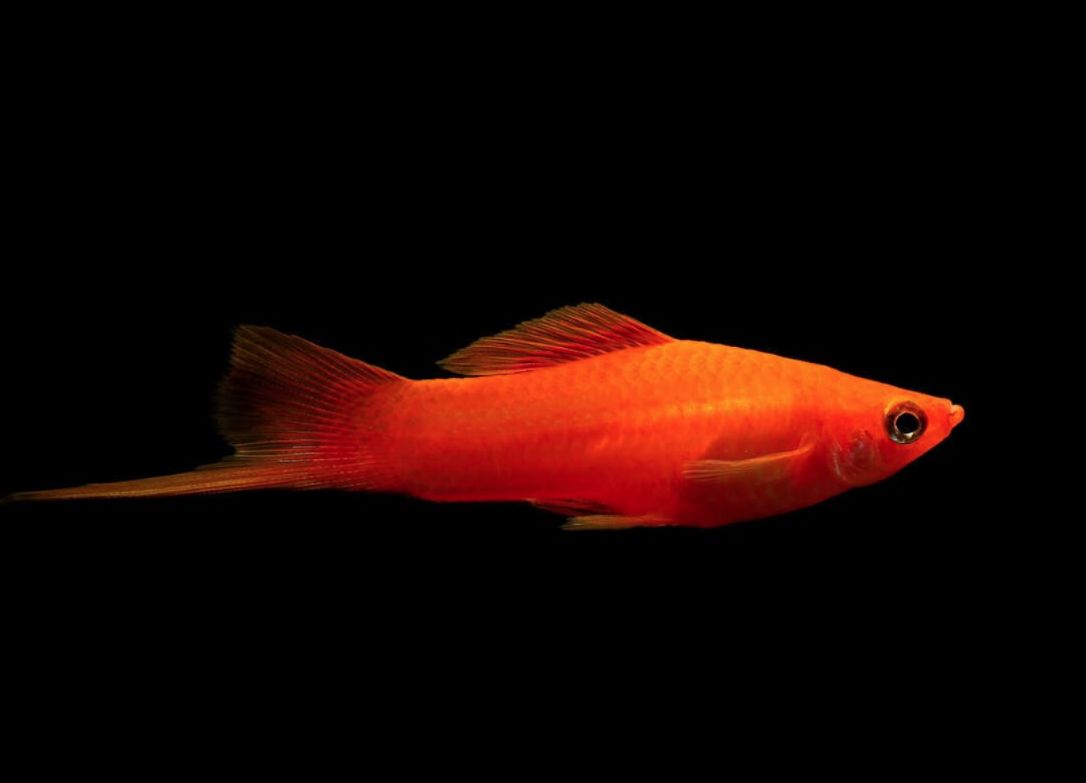
Contents
Habitat in the wild
The swordtail is a popular freshwater fish that belongs to the family Poeciliidae, which is also known as the livebearer family. The scientific name for the swordtail is Xiphophorus hellerii. Xiphophorus helleri is translated from Greek like «xiphos» – a sword, «phoros» – to carry. Prefix «Helleri» was added to the name by the name of German natural philosopher (Karl Bartholomä us Heller), who was the first to catch the fish in Mexican lakes and successfully brought it to Europe. In 1848 the fish was first described by doctor Johan Hekel, a laboratory assistant at museum of natural history under Imperial Natural History Museum in Vienna.
Swordtails are native to Central America, particularly Mexico, and they are commonly kept in aquariums around the world due to their vibrant colors and active nature. Mainly within areas adjacent to Atlantic coast – Mexico, Guatemala, Honduras. The swordtail fish is encountered both in mountain rivers with strong flow and in their lower reaches as well as in lakes, bogs and lagoons. Prefers shallow, thickly planted areas, where they feed on various insects, algae and detritus. These environments are characterized by warm water temperatures and ample vegetation.
Here are some key features of the swordtail’s natural habitat:
- Water Parameters: Swordtails inhabit waters with temperatures ranging from around 70 to 82 degrees Fahrenheit (21 to 28 degrees Celsius). The water is typically slightly alkaline to neutral in pH, with a range of around 7.0 to 8.5. They can tolerate a range of water hardness levels, but generally prefer slightly hard to moderately hard water.
- Vegetation: Their habitat is often rich in aquatic vegetation, including submerged and floating plants. These plants provide hiding spots for fry and shelter for adult swordtails. The vegetation also contributes to the water quality by helping to regulate oxygen levels and provide natural filtration.
- Substrate: Swordtails are found in areas with various substrates, including gravel, sand, and mud. They may also utilize the cover provided by rocks, roots, and submerged branches.
- Water Flow: While they can be found in slow-moving or stagnant waters, swordtails do prefer some water flow. In their natural habitats, they can be found in areas with gentle currents, such as along the edges of rivers and streams.
- Diverse Food Sources: Their diet in the wild includes a mix of algae, aquatic plants, insects, and small crustaceans. They are opportunistic feeders and will graze on available food sources in their environment.

Description
Size
Size may be quite large. Swordtail fish males may grow to be about 4 inches (11 cm) long. Females are about 16 centimetres (6.3 in) excluding the tail length. However, the fish is smaller in tanks, which highly depends on tank conditions. Providing a proper diet, suitable tank conditions, and good care can contribute to the healthy growth of your swordtail fish.
Lifespan
The average lifespan of swordtail fish in captivity is typically around 2 to 3 years. However, with proper care, a healthy environment, and good husbandry practices, swordtails can potentially live longer. Some well-cared-for swordtails have been known to live up to 5 years or even slightly longer.
Body
The body is elongated and flatted from sides. The feature of the fish is its unusual tail in a shape of sword, which actually gave the name to it. Swordtails are known for the distinctive extension of their lower caudal fin, which resembles a sword, giving them their name. This elongated fin is more pronounced in males and is used as a visual display and for mating purposes. Females typically have a more rounded and less elaborate fin. The tail may be either rounded with one ray or it may have several rays.
Coloring
As for the coloring, it difficult to select just one pattern, though red with black tail seems to be the most spread one. It’s quite a complicated task to describe all the species, since there is a large variety of its hybrids.
| Characteristic | Description |
|---|---|
| Scientific Name | Xiphophorus hellerii |
| Family | Poeciliidae (Livebearer family) |
| Origin | Central America, primarily Mexico and northern Central America |
| Habitat | Freshwater streams, rivers, ponds, and ditches with vegetation |
| Size | Adult males: 2.5 – 4 inches (6 – 10 cm), Adult females: 3 – 5 inches (7 – 12 cm) |
| Lifespan | Average 2 – 3 years in captivity, longer with proper care |
| Body Shape | Streamlined, slightly elongated body with distinct dorsal and anal fins |
| Fin Features | Males have an elongated lower caudal fin (“sword”), females have a more rounded fin |
| Colors | Various colors and patterns, including red, orange, black, and combinations |
| Behavior | Active and social fish, compatible with many community fish |
| Water Temperature | 70 – 82°F (21 – 28°C) |
| Water pH | 7.0 – 8.5 (slightly alkaline to neutral) |
| Water Hardness | Slightly hard to moderately hard water |
| Diet | Omnivorous, eats algae, plants, insects, and small crustaceans |
| Reproduction | Livebearers: Females give birth to live fry, store sperm for multiple batches |
| Tank Requirements | Well-planted aquarium, hiding spots, gentle water flow |
| Compatibility | Generally peaceful, compatible with other peaceful community fish |
| Sexing | Males have the distinctive “sword,” females have a rounded anal fin |
| Special Considerations | Provide both plant-based and protein-rich foods, monitor water quality closely |
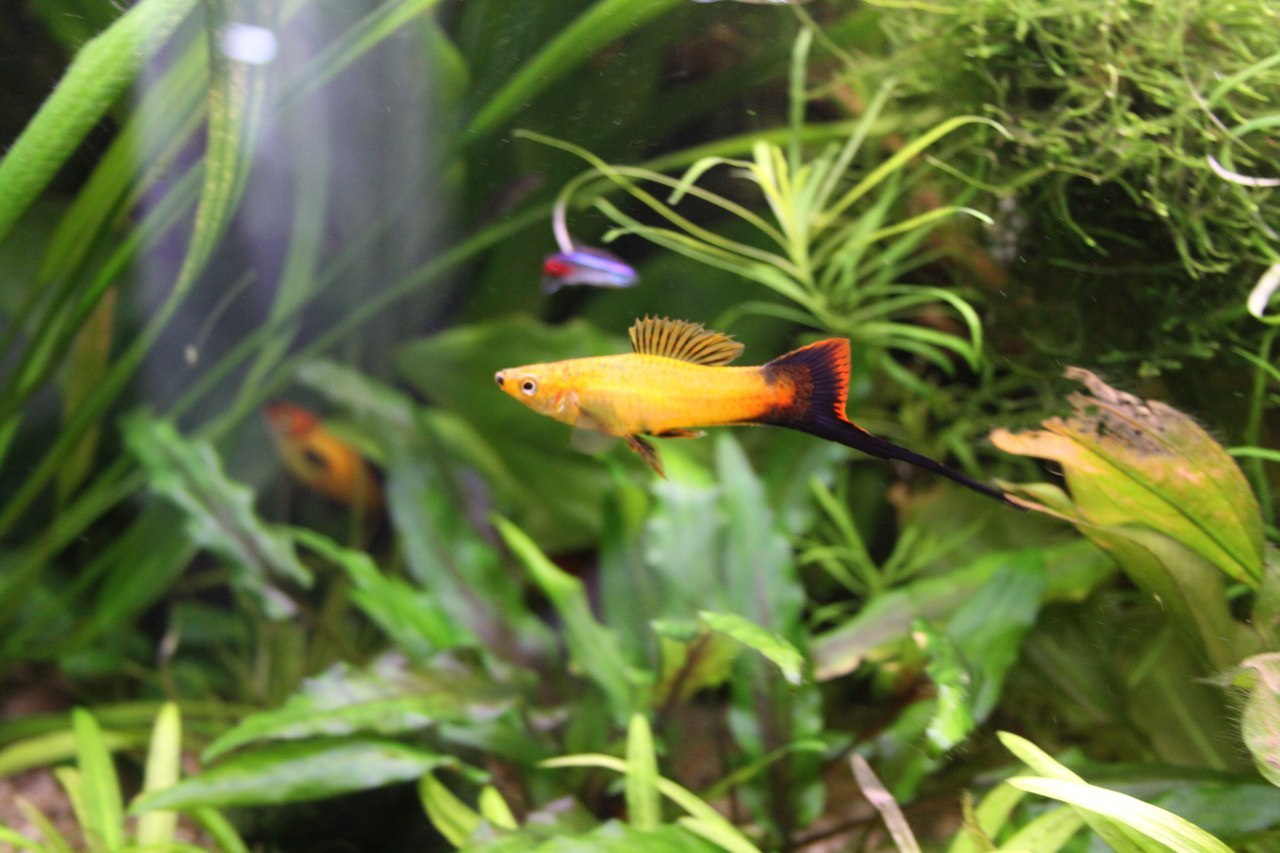
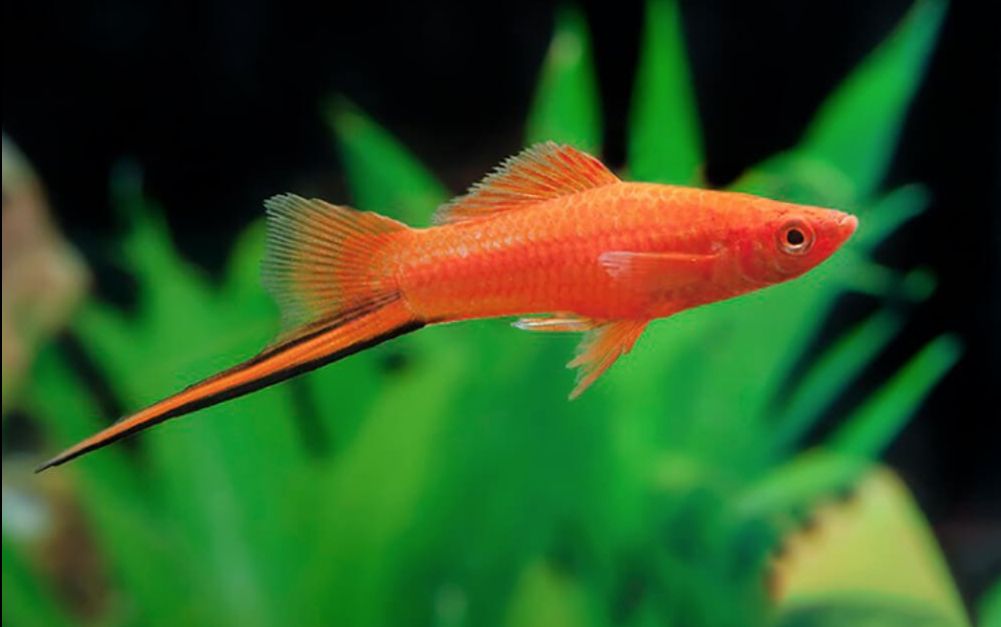
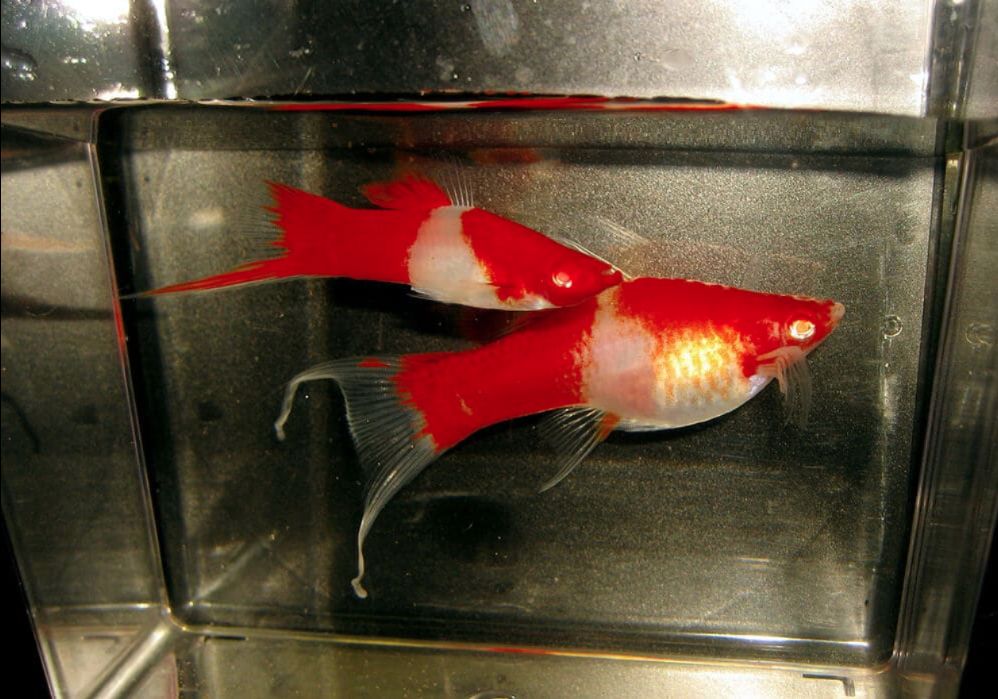
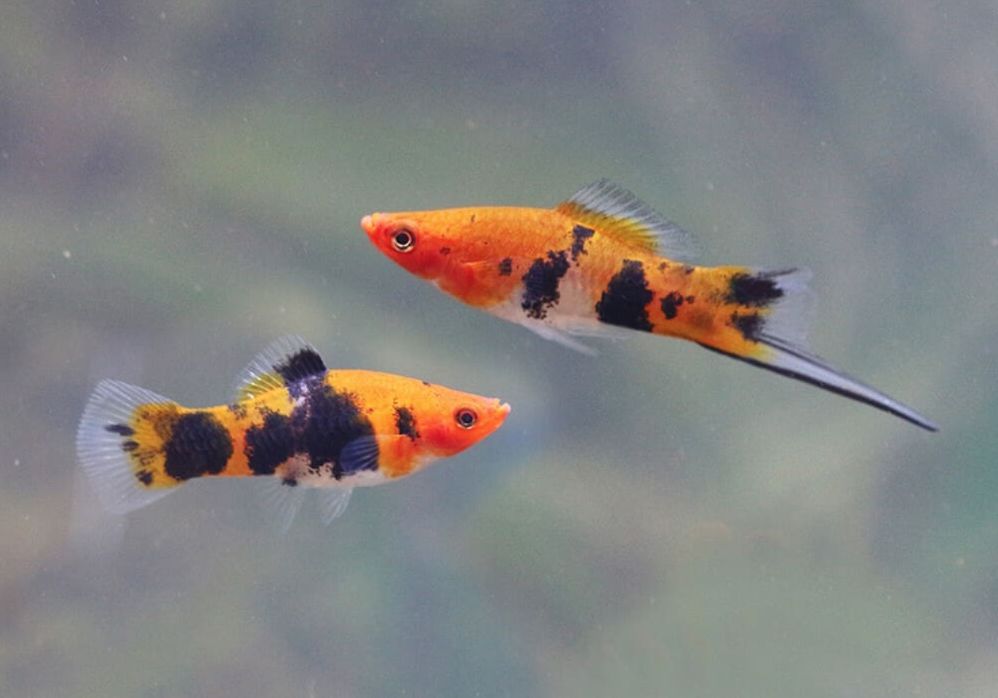
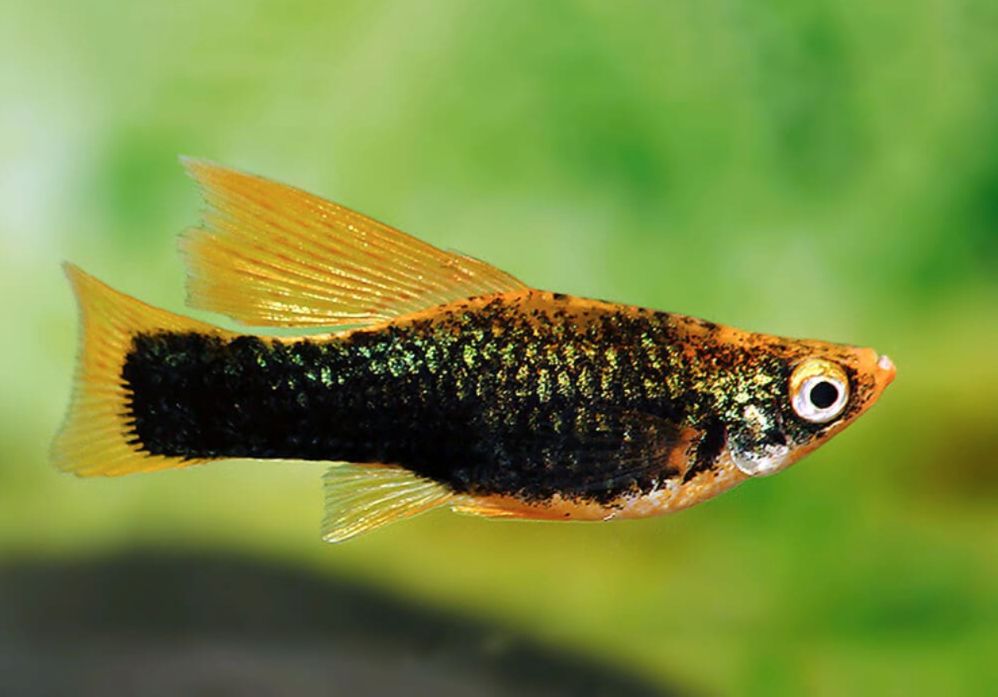
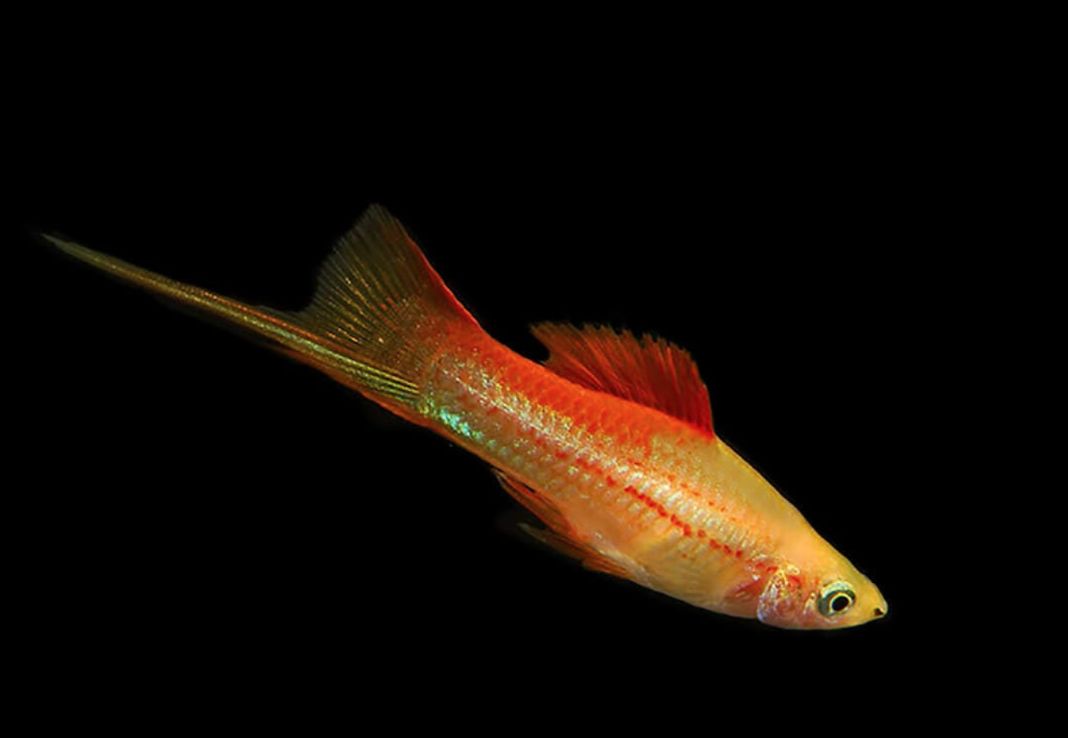
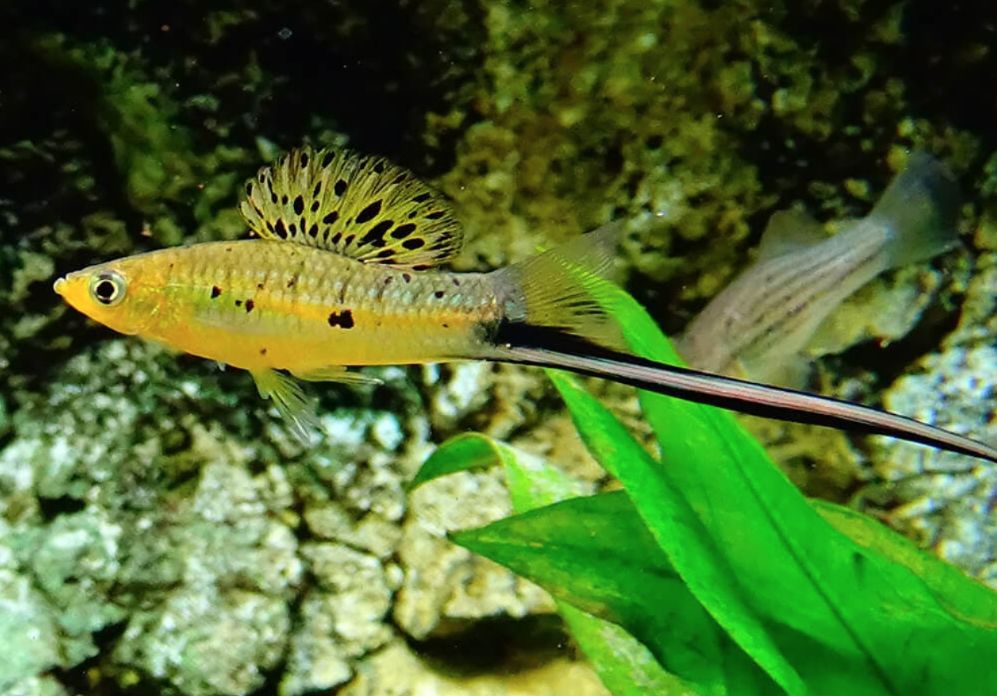
Difficulties in keeping
This is one of the most popular fish for beginners. It’s not demanding, not very large, easy to breed. As for demerits you may find – some males are bully, especially towards each other.
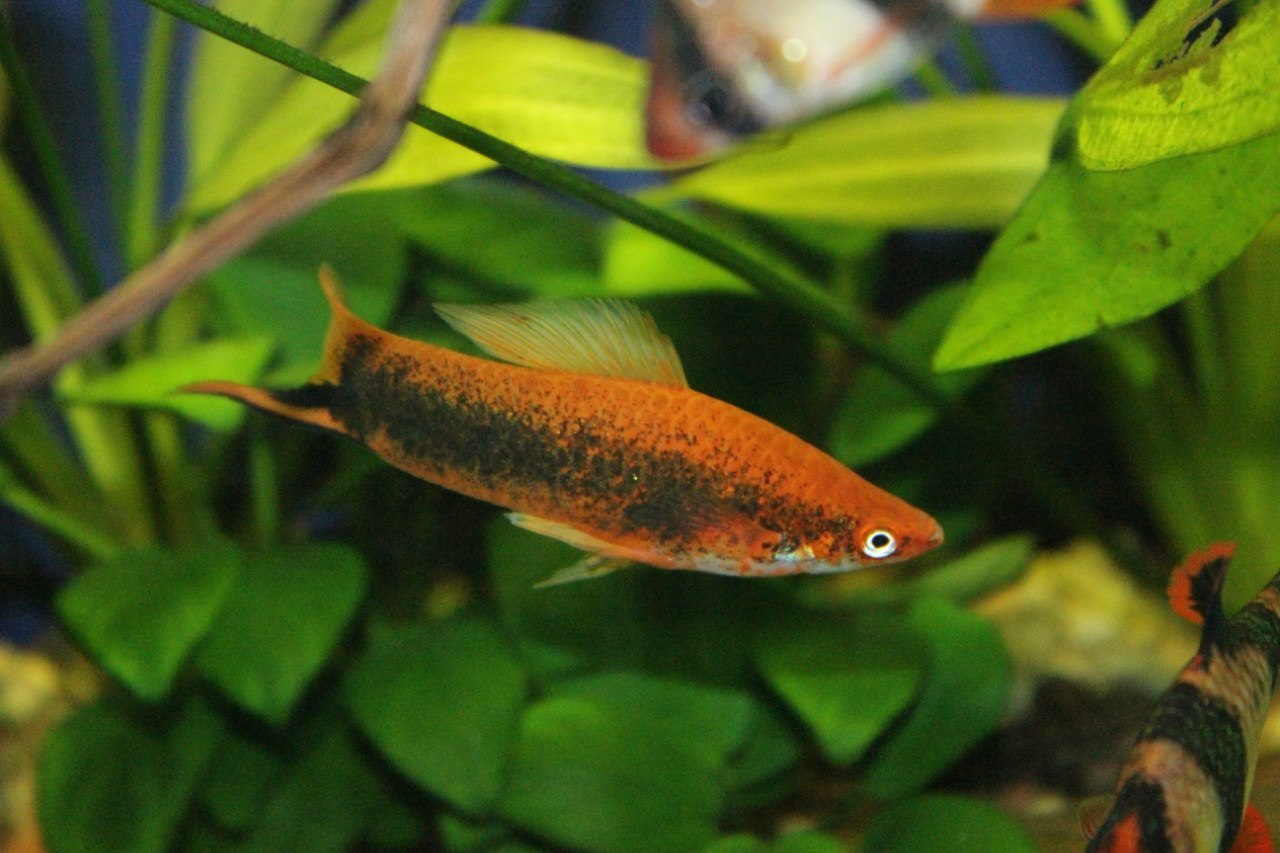
Keeping in the tank
Tank size
The recommended tank size for swordtail fish depends on several factors, including the number of fish you plan to keep, the presence of other tank mates, and the available space in your home. Swordtails are active swimmers and appreciate space to move around, so a larger tank is generally better for their well-being. Here are some guidelines to consider:
- Minimum Tank Size: In fact, is quite a large fish. Therefore, I’d recommend for a small group of swordtails (1 male and 2-3 females), a tank with a capacity of around 20 to 30 gallons (75 to 113 liters) is generally considered the minimum. This allows for enough swimming space and provides the females with separate areas to retreat if the male becomes overly aggressive. Remember, that for breeding you’ll need one swordtail male and 2-3 females. If there is just one male and a female, he’ll be haunting her all the time and she’ll be stressed, which may cause the death.
- Larger Groups: If you plan to keep more swordtails, increase the tank size accordingly. For instance, a larger group of swordtails might require a tank in the range of 40 to 55 gallons (150 to 208 liters) or more.
- Compatibility: If you’re considering keeping swordtails with other fish species, take into account the needs of those species as well. Additional tank mates will require more space, so you’ll need to adjust the tank size accordingly.
- Aquascape and Plants: Swordtails also benefit from having ample hiding spots and plants in the tank. Live plants provide hiding places, help with water quality, and create a more natural environment. Consider the space these elements will occupy when determining the tank size.
- Males and Territories: Keep in mind that male swordtails can be territorial and may chase females or other males. Providing hiding spots and breaking up the line of sight in the tank can help alleviate aggression. Try not to put several males into one tank, since they have strongly pronounced hierarchy. The male in charge will always be chasing other males and it is followed by fights, injuries, stress.
Remember that these are general guidelines, and individual circumstances may vary. Providing more space than the minimum requirement can contribute to the health and well-being of your swordtails and the overall stability of the aquarium environment. Before setting up your tank, consider the number of fish you plan to keep, their behaviors, and the compatibility of different species to determine the appropriate tank size for your specific situation.
Water parameters
Swordtail fish is rather not demanding, such parameters as water hardness and pH aren’t very important for the swordtail fish. It’s important to note that while swordtails are adaptable fish, sudden and extreme fluctuations in water parameters can stress them and lead to health issues. Regular monitoring of water parameters, maintaining a stable environment, and providing appropriate care will go a long way in keeping your swordtails healthy and thriving.
Here are the recommended water parameters for keeping swordtails in your aquarium:
- Temperature: Swordtails thrive in water temperatures ranging from 70 to 82°F (21 to 28°C). Keeping the water within this temperature range is important to prevent stress and ensure their overall health.
- pH Level: Swordtails prefer slightly alkaline to neutral water conditions. Aim for a pH range of 7.0 to 8.5. It’s generally a good practice to keep the pH stable, avoiding rapid fluctuations.
- Water Hardness: Swordtails can tolerate a range of water hardness levels, but they tend to do well in slightly hard to moderately hard water. Aim for a general hardness (GH) level of around 8 to 20 dGH.
- Ammonia, Nitrite, and Nitrate: Ammonia and nitrite levels should be kept at zero, as they are toxic to fish. Nitrate levels should be regularly monitored and kept below 40 ppm, as elevated nitrate levels can negatively impact fish health.
- Water Quality: Regular water changes are crucial to maintain good water quality. Aim for partial water changes of around 20% to 30% of the tank volume every 1-2 weeks to remove accumulated waste and replenish minerals.
- Filtration and Aeration: Efficient filtration and gentle water movement help maintain water quality by removing waste and providing oxygen to the fish. Make sure to choose an appropriate filter for your tank size and consider adding an air stone or bubbler for aeration.
- Chlorine and Chloramine: Tap water often contains chlorine or chloramine, which are harmful to fish. Treat tap water with a water conditioner to neutralize these chemicals before adding it to the aquarium.
Tank decor
Keep in mind, that fish not only swims fast, it also jumps well. Therefore, tank must be covered, otherwise you may find dead fish on the floor near the tank. You can choose tank decorations at your discretion. The only thing is, that it should be thickly planted. For the female it is easier to hide in plants from aggressive males and if she spawns the juveniles will not be eaten right away.
Tank mates
The swordtail fish is considered to be a peaceful one, but my experience shows that it’s not always true. They have very strong intrageneric aggression. Besides, old males may attack other fishes in a tank, but this depends on a specific temper.
Some fishes live peacefully and some of them become bully, start haunting young males and other fishes. Small tanks without plants encourage aggressive behavior of the fish. What you definitely shouldn’t do, is to keep two or more swordtail males in one tank. This guarantees fights in the tank.
Though they will not kill each other, but constant stress leads to death of the weakest male. There are two ways how you can settle the issue: keep one male and 3-4 males in a tank or lots of males in a spacious tank with females.
This way there is no obvious leader between the swordtail fish and aggression in spread uniformly (not just one and the same fish suffers). As a rule, they tend to be neutral to their tank mates.
So, the best tank mate is fish of the same size, but not a predator one. This can be:
- Harlequin Rasboras (Trigonostigma heteromorpha)
- Neon Tetras (Paracheirodon innesi)
- Ember Tetras (Hyphessobrycon amandae)
- Glowlight Tetras (Hemigrammus erythrozonus)
- Black Neon Tetras (Hyphessobrycon herbertaxelrodi)
- Cardinal Tetras (Paracheirodon axelrodi)
- Rummy Nose Tetras (Hemigrammus rhodostomus)
- Dwarf Gouramis (Trichogaster lalius or Trichogaster chuna)
- Sparkling Gouramis (Trichopsis pumila)
- Celestial Pearl Danios (Danio margaritatus)
- White Cloud Mountain Minnows (Tanichthys albonubes)
- Dwarf Rasboras (Boraras spp.)
- Endler’s Livebearers (Poecilia wingei)
- Guppies (Poecilia reticulata)
- Platies (Xiphophorus spp.)
- Corydoras Catfish (Corydoras spp. – pygmy cory, panda cory, adolfoi catfish)
- Otocinclus Catfish (Otocinclus spp.)
- Bristlenose Plecos (Ancistrus spp.)
Diet
Swordtails (Xiphophorus hellerii) are omnivorous fish, meaning they eat a variety of plant and animal-based foods. You can feed it with artificial, live or frozen food. Like all other fishes diet should be diversified. It is especially important to provide it with vegetable food. The thing is, that in the wild major part of the diet consists of thin algae and other fouling. Here’s a guide to their diet:
- High-Quality Flake or Pellet Food: A good staple food for swordtails is high-quality flake or pellet food designed for tropical fish. Look for options that contain a variety of nutrients, including protein, vitamins, and minerals.
- Live Foods: Swordtails enjoy live foods, which mimic their natural diet. Offer live foods like brine shrimp, daphnia, and bloodworms as occasional treats. Live foods are particularly beneficial for breeding pairs and growing fry.
- Frozen Foods: Frozen foods are convenient and nutritious options. You can find frozen brine shrimp, daphnia, and other small aquatic organisms at pet stores. Thaw and rinse frozen foods before feeding.
- Vegetables and Algae-Based Foods: While swordtails are not strictly herbivores, they do benefit from having some plant matter in their diet. You can offer blanched vegetables like spinach, zucchini, and lettuce. Additionally, you can find algae-based foods in the form of wafers or pellets, which can provide a source of natural fiber. To have such amount of algae in a tank is impossible, but you always can buy flakes with vegetable supplements. You can make these flakes a basic component of the diet and add live food as a supplement.
- Specially Formulated Diets: Some commercial foods are specifically formulated for livebearers like swordtails. These diets may contain a mix of plant and animal-based ingredients to meet their nutritional needs.
- Frequency and Portion Control: Feed your swordtails small amounts multiple times a day rather than one large feeding. This mimics their natural feeding behavior and prevents overfeeding, which can lead to water quality issues.
- Variety: Providing a variety of foods helps prevent nutritional deficiencies and encourages natural foraging behaviors. Mix up their diet with a combination of dry, frozen, live, and vegetable-based foods.
Remember that swordtails are opportunistic feeders, so they may also nibble on algae and small organisms found in the aquarium. Be cautious not to overfeed, as excess food can lead to water quality problems. Monitor your fish’s behavior and adjust their diet based on their activity level and overall health.
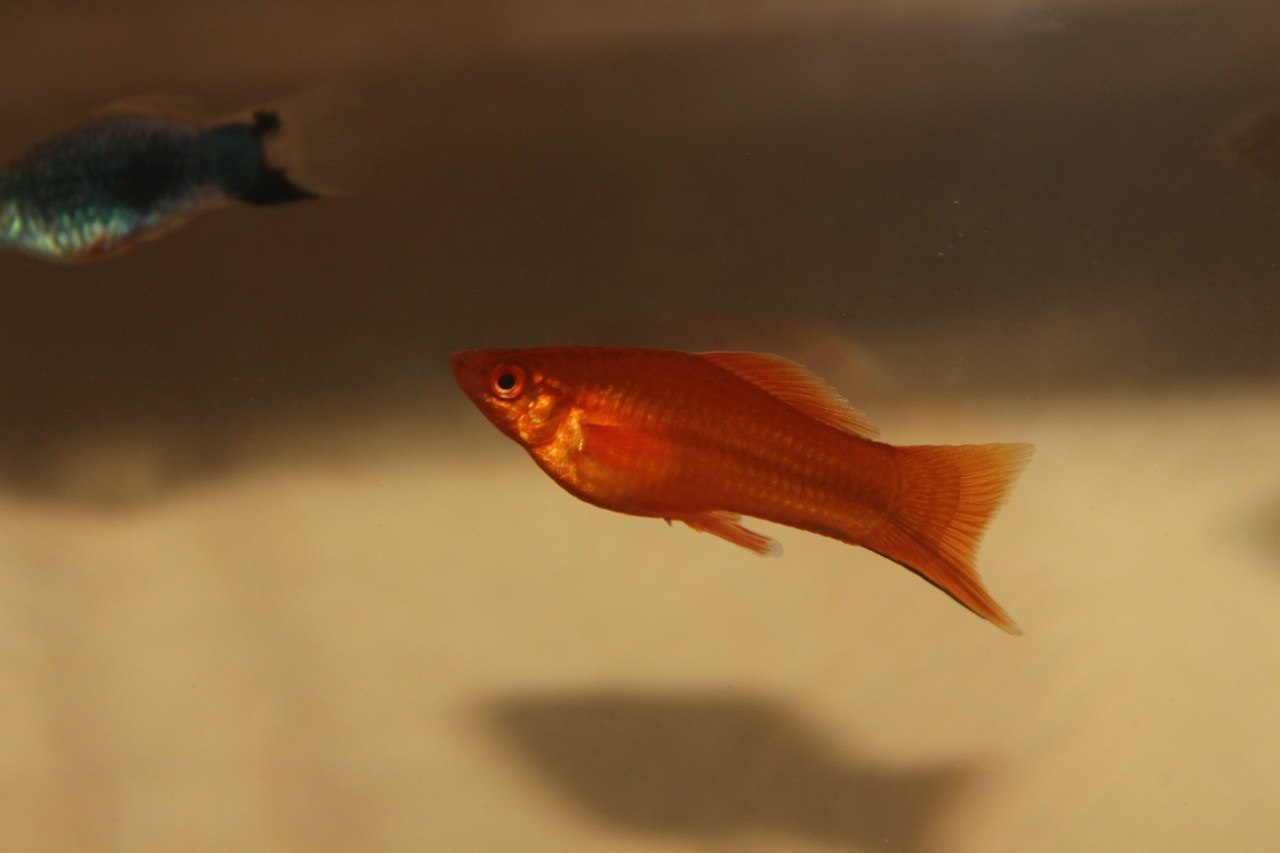
Gender differences: male vs female
It is extremely easy to see between swordtail fish male and female. Male and female swordtail fish (Xiphophorus hellerii) have distinct differences in their appearance and behavior. Here are some key characteristics that differentiate male and female swordtails:
Male Swordtail:
- Sword Tail: The most prominent feature of male swordtails is their elongated lower caudal fin, often referred to as the “sword.” Only male has a sword on its tail. This fin extends beyond the rest of the tail and gives the fish its name.
- Size: Males are generally smaller than females, with an average length of about 2.5 to 4 inches (6 to 10 cm).
- Coloration: Male swordtails tend to have more vibrant and colorful patterns compared to females. They often display a combination of colors, including red, orange, black, and sometimes blue or green.
- Gonopodium: ust like all live-bearing fish the anal fin of the male has been modified into a tube (gonopodium) and the female has a wide anal fin. This specialized fin is used for mating and differs in shape from the female’s anal fin.
- Behavior: Male swordtails are known to exhibit more territorial and aggressive behaviors, particularly towards other males and sometimes towards females. They may chase other fish, especially if they feel threatened or during mating displays.
Female Swordtail:
- Anal Fin: The anal fin of females is rounded and lacks the modified structure found in males. It does not serve a reproductive function like the gonopodium.
- Size: Females are generally larger than males, with an average length of about 3 to 5 inches (7 to 12 cm).
- Coloration: Female swordtails usually have more subdued and less vibrant colors compared to males. Their coloration might include shades of gray, silver, or pale yellow.
- Pregnancy: Female swordtails are livebearers, which means they give birth to live fry. When pregnant, they may develop a gravid spot near their anal fin, which is a dark area that indicates the presence of developing fry.
- Behavior: Female swordtails are generally less aggressive than males and tend to be more social with other fish in the tank. They may seek hiding spots when pursued by aggressive males.
When keeping swordtails in a community tank, it’s recommended to have more females than males to reduce aggression and stress on the females. Providing plenty of hiding spots and plants can also help alleviate aggression. Observing the differences between male and female swordtails will not only help you identify their sex but also give you insights into their behaviors and interactions within the aquarium.
Breeding
Is a live-bearing fish, that is its juveniles appear not as eggs, but as a completely formed small fish. The swordtail fish male fertilizes eggs inside the females body and she carries them till she is ready to spawn. Usually this period lasts for 28-30 days.
It is very easy to get juveniles, just like from other live-bearing fish (guppy, molly). The female fish can even spawn without the male, because she stores male milt inside her and can fertilize the eggs herself. Therefore, if the female fish spawned and there is no male fish in a tank, this is the case.
Swordtail becomes reproductive at the age of 5-6 month. For breeding (and also for the fish to feel comfortable) it’s recommend to keep the fish in ratio – 1 male for 3 females.
The easiest way to stimulate breeding is to raise the temperature of tank water. Ammonia and nitrates level should be as low as possible and pH 6.8-7.8. When the female becomes fatter watch the dark spot near her anal fin.
As the spot gets darker and the fish becomes significantly fat, the spawning will happen very soon. This dark spot is actually juveniles eyes which are seen through her body. The female spawns from 15 to 100 and more juveniles at a time. Spawning usually occurs in the morning.
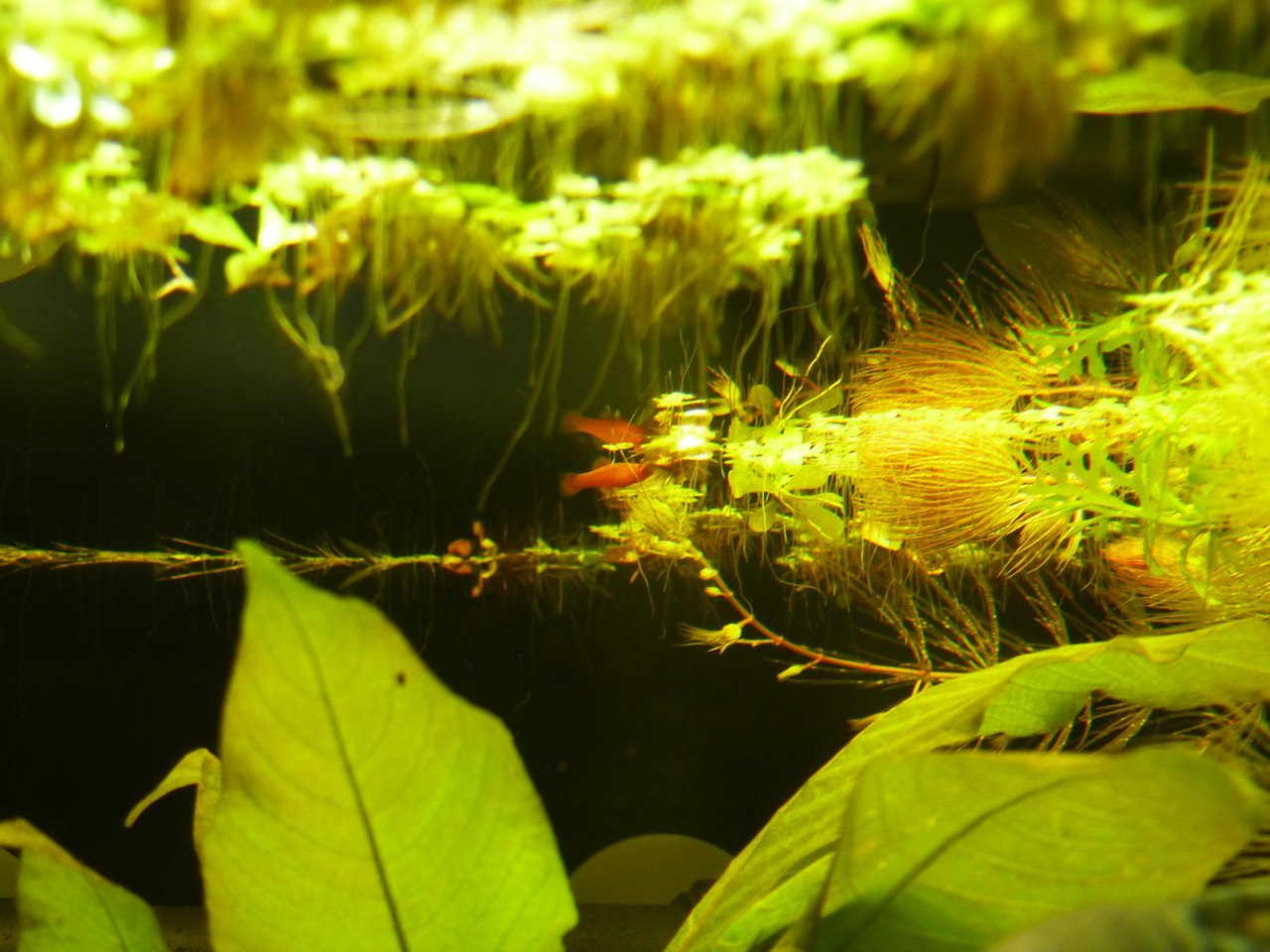
It seems to me, that the most important rule you should follow when breeding swordtail – its taking care of its juveniles. Unfortunately, parents eat their own offspring. Taking into account that juveniles are quite large and brightly colored – it looks like extermination.
In the wild swordtail fish never sees its offspring, since the juveniles go with the water flow right after they are born. In the tank parents take them for food. To save the offspring the tank should be thickly planted. Plants are put on the tank bottom, in the water and they should be especially thick on the water surface.
This way you provide the juveniles with shelter from aggressive parents and most of juveniles survive.
Also to safe the offspring you may use a special depositing hopper – the swordtail female stays in it and the juveniles fall into a spawning tank after they are born. This way you prevent any contact between the offspring and its parents.
The third option to keep the juveniles safe is to remove their parents from the tank right after spawning. This is an easy way, but it in this case aquarist should be attentive and timely.
Juveniles are large, active and hungry. You can feed them with egg yolk, food for juveniles and brine shrimp nauplii. It’s desirable to add spirulina or flakes with vegetable supplements. Provided with spirulina+live food diet the juveniles will grow fast and have bright coloring.